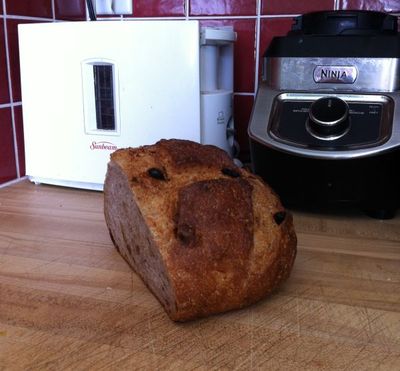
This Walnut Raisin Sourdough is four days old. I had a slice for lunch today and it was delicious!
Have you ever seen those pictures of a fast food hamburger that can sit, unchanged, for months at a time? Well, that's not going to happen with Orange Boot bread. Even though our bread keeps well for a good long time, it won't last forever. We don't use any artificial preservatives in our baking, so there's a limited shelf life to all our bread.
In a perfect world, everyone would have the time to walk to their neihbourhood bakery each day to pick up a fresh loaf of bread. Sadly, Regina isn't perfect, except for a few lucky people in Albert Park. The rest of us need to think about how to care for our bread so it will keep for a few days after we bring it home.
Here's what Cindy and I do so our bread at home is great to eat three, four or even five days after it's baked.
Leave Your Bread at Room Temperature #
Remember the Bread Box? Not only were they a standard unit of measure (everything in the world was either bigger or smaller than one) but they helped keep bread fresh longer, by forcing you to keep your bread out of the fridge.
Refrigeration is the single worst thing you can do to a loaf of bread. The cold (but not frozen) temperature is perfectly suited for staling. Your bread will go stale faster in the fridge than anywhere else in your house.
Love the Crust #
I love a good crispy crust in my bread. The crust in a well baked loaf contains over 70% of the flavour, and the contrast between the crisp crust and soft crumb adds to the overall eating pleasure. So my first priority is to preserve the crust for the first day or so.
The best thing to do for the first day or two when you bring your loaf home is to leave it in its paper bag. When you slice the loaf, keep the end piece, place it over the freshly cut end and place everything back in the paper bag.
Kept in paper, your loaf will not mold, because there is plenty of opportunity for your loaf to breath and expell moisture from the crumb, through the crust and the paper bag, into the air. After a day or two, however, your loaf may have expelled enough moisture that it is starting to get a little too dry and hard. Your loaf is slowly starting to stale, so it's time to move to Phase 2.
Finish in Plastic #
If, after you've had your Orange Boot bread home for two days and still haven't managed to eat it all, it's time to move the loaf to a plastic bag. This will slow down the staling process, but has some unfortunate side effects:
- Your crust will turn soft. The moisture that continues to drift out from the crumb and through the crust will get trapped in the plastic bag. While that helps keep the overall loaf moist, it will make your crust soft too.
- Your bread might mold. This usually won't happen for another 3-4 days (that is, 4-6 days after you bring your bread home) but that warm, moist environment is perfectly suited to mold development.
So by the time you have moved your loaf to plastic, it's time to think about using it up. Morning toast, grilled sandwiches for lunch, french toast for supper, bread pudding and croutons are all great options. You could even dry your sliced bread till they are hard and whizz them in a blender for awesome bread crumbs.
Natural Preservatives #
There is one thing we do at Orange Boot to help your bread keep a good long time. Our traditional long fermentation baking methods (both using wild yeast "sourdough" cultures or baker's yeast) naturally raise the ph levels in the dough. Not only does this extra acidity add a lot of flavour to the bread, it helps prevent staling. Your great tasting Orange Boot bread will keep longer too.
You may have also noticed that our Orange Boot Birdseed Bread keeps an exceptionally long time. That's because of all the seeds in the Birdseed Bread hold moisture, so your loaf will stay fresher longer. And taste pretty amazing too.